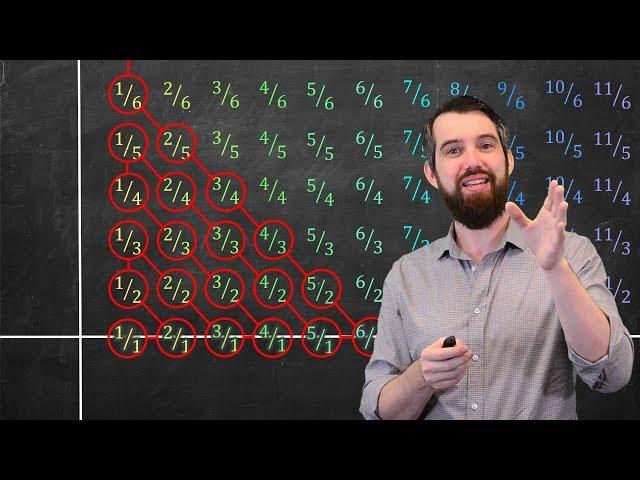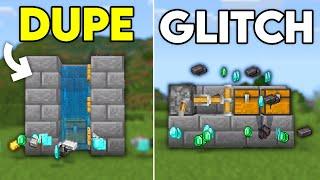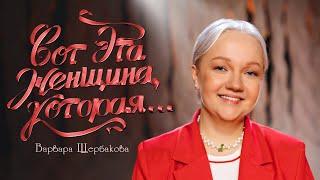
Integers & Rationals are both infinite but is it the SAME infinity?
Комментарии:

I think irrationals have bigger 'size' than integers
Ответить
You are such a great teacher 😊.Thank you so much...❤
Ответить
Is the same order we will find 22/7 in this table of rational numbers which is equal to pi an irrational number ......so how this method is true... Plzzzz tell me
Ответить
You forgot zero✌️
Ответить
WONDERFUL.. many THANKS
Ответить
This along with all other proofs of countable sets work only because of ONE REASON; we humans don't have a grasp of infinity. It feels intuitively dishonest that all the natural numbers can be put into 1-1 correspondence with all the natural numbers, and at the same time all the even numbers can be put into 1-1 correspondence with the same natural numbers. I strongly think that all those proofs rely or lean on our ignorance of the infinite, because they don't work for finite sets.(which we humans have a firm understanding of). It's the same reason that Hilbert's hotel works, simply because infinity is a black box, or the magician's trick of choice. It's like anything you don't understand, you can just pass it through that black magic box, and it works for an incomprehensible reason, but the results line up with our logic.
Ответить
You are such an inspiring teacher. Thank you for your passion and time to break things down!! This was eye-opening!!! Love the vids!!! :D
Ответить
🧡
Ответить
Just nailed it, Solved by countability doubt in Theory of Computation. Love from India 💕
Ответить
The diagram with a zigzag path is so illustrative
Ответить
Genius!!
Ответить
What about negative rational numbers??
Ответить
Great video, you're a great teacher. Thanks!
Ответить
thank you so much, sir
Ответить
I think irrational no. sets is bigger than rational no. because we can never line them up...there are infinite no. of digits in a single irrational no. itself.
Ответить
ngl, it almost feels like our math is flawed if we consider them the same size, one is an infinite line and the other is an infinite square that can be zigzagged into a line
Especially in my case, I am trying to find a function from Q (rationals) to N (naturals or positive integers) and it needs to be injective, meaning each element from the starting group Q should have a unique image in the landing group N, no two elements should share the same image, (if f(a) = f(b), it should mean that a = b, because no two have the same image), if we consider the two groups the same size, we should be able to assign them in this way, but I just can't seem to visualize it at all (abstractly or graphically), the explanation of the zigzag is pretty cool to visualize that its countable or "listable", but there is no real logic beyond visualization, there is no way you could tell me what's the Nth number is unless you count by hand, which yeah, isn't really practical if you ask me
maybe I am missing something but this feels like a paradox and that there is no such function

I wonder if Cantor had anyone he could hug when he first noticed this. What a lonely moment if not! He would shake your hand if he could on your rendering of his famous diagonal argument
Ответить
Excellent break down. He did not take anything for granted. Gradually building by using clear visual presentations. Concepts in mathematics can be easier understood when visualized. Nice work.
Ответить
This was an excellent video. I struggled with this proof for so long, but you made it clear in a very short amount of time. I do have a question though, can you map from the naturals to the negative integers, since the naturals have no negative elements by definition?
Ответить
The notion countability has been disproved.
If all positive fractions can be enumerated, then the natural numbers of the first column of the matrix
1/1, 1/2, 1/3, 1/4, ...
2/1, 2/2, 2/3, 2/4, ...
3/1, 3/2, 3/3, 3/4, ...
4/1, 4/2, 4/3, 4/4, ...
5/1, 5/2, 5/3, 5/4, ...
...
can be used to index all fractions (including those of the first column). In short, there is a permutation such that the X's of the first column
XOOOO...
XOOOO...
XOOOO...
XOOOO...
XOOOO...
...
after exchanging them with the O's cover all matrix positions. But this is obviously impossible.

Dear Dr. Bazett. Topologically speaking the interior of Q (rationals - an aleph0 set) is empty. Lots of people tell me that the interior of R\Q is also an empty set. I believe that the interior of R\Q is at least an aleph0 set. I hope this is not a Godel/Cohen issue, but it just may.......could you share some thoughts please? Thanks very much.
Ответить
Yes, you can show that the set of Rationals is listable. It's like taking the full set of Natural numbers, and
add more natural numbers to it. Sure, all the positions of the Natural numbers are filled up, but you can
always find more empty positions by moving values around. For example, you can relabel all Natural
numbers to the position plus 1 to fit in one extra number, and move numbers to position times 2 to
fit in an infinity of new numbers, and so on.
You could also pair up the Natural numbers with the same natural number values in the Rational number set.
That way you can see that the actual infinite number of rational numbers is bigger, since it contains infinitely
many values that are not found in the set of natural numbers. This method works when the two sets have the
same elements, so that these can be paired off, and then you simply compare the rest of the elements.
For Rationals, they then get a different number of infinite elements, about N^2, depending on the definition
of them, and if you remove numbers with similar values.

How can you just throw away 2/2? That's something thats always bothered me about this method. You don't hit every number exactly 1 time some numbers get hit more then 1 time. This in my mind feels like a cheat and that should suggest the rational numbers are smaller then countable numbers.
Ответить
Excellent explanation. Thank you
Ответить
Literally makes no sense, for every integer there’s an infinite amount of rational numbers (between 0-1, 1-2…) So how can there be the same amount?
Ответить
cantors argument is flawed....once you create the infinite set...its by definition bijective with natural numbers..the diagonal exists too. the compliment of the diagonal existed too. if you rearrange the real numbers then there is no contradictions that occur with the original complimented diagonal line. however there is a contradiction with the compliment of the new diagonal...however its a different number..so basically the impossible or contradicting numbers include all real numbers. that is illogical..thus the original argument is faulty.
Ответить
I like also the Stern-Brocot tree. It is quite elegant.
Ответить
What a waste of time
Ответить
Wow!! Just Wow!! Eye Opening!!
Ответить
Hello professor, your videos are great and helpful but please accept my critique. I don't know about other people but I find your speech to be of high volume and really quick which makes not enjoying when I am listening. Try to make it more soothing and peaceful. Other than that, your are really great.
Ответить
Great video. However, I didn't understand how would you biject the negative and positive together..?
Ответить
Thank you so much for this amazing and patient explanation! It is really helpful to me!
Ответить
Well thats not the case that every positive infinite set has the same size,as in case of set of real number we cannot map it with integers..
Ответить
Answer for the final question is No.
Ответить
I don't get why that method of elimination is justified isn't the 1/1, 2/2 being the same just matter of encoding the numbers in that format?
Ответить
Anyway I could reach out to you to show you a method I came up with that would suggest all real numbers are countable? It’s based off this model with some tweaks!
Ответить
this video saved my life
Ответить
You can generate an infinite set of rational numbers with a single numerator with natural number p. You can then create a similar infinite set of rational numbers for each denominator q. If there is a correspondence for each combination p/q with a natural number p, then why does this fail when going from rationals to reals?
Ответить
Since the number 1 appears multiple times in the rational number grid (as 1/1, 2/2 etc.) have you actually shown that the set of rational numbers is smaller because there is not a strictly one to one mapping with the integers?
Ответить

























